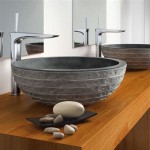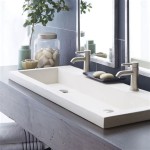Bathroom Sink Essentials: A Comprehensive Guide
The bathroom sink, often called a wash basin or lavatory, serves more than just a practical function in the bathroom. It is a focal point, contributing significantly to the overall aesthetic and usability of the space. Selecting the right bathroom sink requires careful consideration of factors like size, style, material, installation, and budget. This article provides a comprehensive overview of bathroom sink types, materials, installation methods, and considerations to help individuals make informed decisions.
Types of Bathroom Sinks
Bathroom sinks come in a variety of configurations, each offering unique advantages and disadvantages regarding space efficiency, aesthetics, and installation requirements. Understanding the different types is the first step in choosing the best option for a specific bathroom.
Vessel Sinks: Vessel sinks, also known as above-counter sinks, sit entirely on top of the bathroom countertop. Installation is generally simpler compared to other sink types as it typically only requires drilling a hole for the drain and faucet. Their prominent appearance makes them a visually appealing choice, offering a modern and often artistic touch to the bathroom.
Undermount Sinks: Undermount sinks are installed beneath the countertop, creating a seamless transition from the countertop surface to the sink basin. This design facilitates easy cleaning as debris can be wiped directly into the sink. Undermount sinks provide a clean and contemporary look, maximizing countertop space.
Pedestal Sinks: Pedestal sinks consist of a basin supported by a freestanding pedestal base. They are a classic choice, particularly suitable for smaller bathrooms where space is limited. The pedestal base conceals plumbing, creating a clean and uncluttered appearance.
Wall-Mounted Sinks: Wall-mounted sinks are attached directly to the wall, freeing up floor space beneath the sink. This type of sink is ideal for barrier-free bathrooms and smaller spaces. Because the plumbing is exposed, a decorative P-trap is often used.
Console Sinks: Console sinks combine a sink basin with a supporting structure, often featuring legs or a metal frame. They offer a blend of style and functionality, providing a surface for storage or display. Console sinks can evoke a vintage or contemporary aesthetic, depending on the design.
Drop-In Sinks: Drop-in sinks, also called self-rimming sinks, are installed into a pre-cut hole in the countertop. The rim of the sink sits on top of the countertop, providing a secure and stable installation. Drop-in sinks are a versatile option, available in various shapes and sizes.
Integrated Sinks: Integrated sinks are seamlessly molded into the countertop, creating a single, continuous surface. This design eliminates seams and crevices, simplifying cleaning and maintenance. Integrated sinks offer a modern and minimalist look, typically found in contemporary bathroom designs.
Bathroom Sink Materials: Properties and Considerations
The material of a bathroom sink significantly affects its durability, appearance, and maintenance requirements. Different materials offer unique advantages and disadvantages depending on the user's needs and preferences.
Porcelain: Porcelain is a classic and widely used material for bathroom sinks due to its durability, stain resistance, and affordability. It is a ceramic material fired at high temperatures, resulting in a smooth, non-porous surface. Porcelain is easy to clean and maintain, making it a practical choice for most bathrooms. However, it can be susceptible to chipping if subjected to impact.
Vitreous China: Vitreous china is a type of porcelain that has been coated with enamel and fired to create a dense, glossy surface. It is more resistant to stains and scratches than standard porcelain. Vitreous china offers a higher level of durability and a more refined appearance.
Glass: Glass sinks are increasingly popular for their modern and artistic appeal. They are typically made of tempered glass, which is highly resistant to shattering. Glass sinks can be clear, frosted, or colored, offering a variety of design options. However, they require more frequent cleaning to maintain their pristine appearance.
Stone: Stone sinks, such as granite, marble, and travertine, offer a luxurious and natural aesthetic. Each stone sink has unique patterns and variations, adding character to the bathroom. Stone sinks are durable and long-lasting but may require sealing to protect them from staining and water damage.
Stainless Steel: Stainless steel sinks are known for their durability, corrosion resistance, and modern industrial look. They are easy to clean and maintain, making them a practical choice for high-traffic bathrooms. Stainless steel sinks are often found in commercial settings but can also be used in residential bathrooms for their sleek and minimalist design.
Concrete: Concrete sinks offer a contemporary and industrial aesthetic. They are durable and can be custom-molded into various shapes and sizes. Concrete sinks require sealing to protect them from staining and water damage. They can also be heavier than other sink materials, requiring additional support.
Cast Iron: Cast iron sinks are known for their durability and classic appeal. They are typically coated with enamel to create a smooth, glossy surface. Cast iron sinks are resistant to chipping and scratching but can be heavy and require professional installation.
Installation Considerations and Plumbing
Proper installation is crucial for the functionality and longevity of a bathroom sink. The installation process varies depending on the type of sink and the existing plumbing configuration. It is important to consider the plumbing requirements before selecting a sink.
Plumbing Connections: The plumbing connections for a bathroom sink include the water supply lines (hot and cold) and the drainpipe. The size and location of these connections must be compatible with the sink's design. It is essential to ensure proper connections to prevent leaks and water damage.
Faucet Compatibility: The faucet must be compatible with the sink's hole configuration. Sinks may have one, two, or three faucet holes, depending on the faucet design. It is important to select a faucet that matches the sink's hole configuration and overall style.
Drain Assembly: The drain assembly includes the drain stopper, tailpiece, and P-trap. The P-trap is a curved pipe that traps water, preventing sewer gases from entering the bathroom. It is important to install the drain assembly correctly to ensure proper drainage and prevent odors.
Countertop Preparation: For undermount and drop-in sinks, the countertop must be properly prepared with a cutout that matches the sink's dimensions. The cutout should be precise to ensure a secure and watertight fit. Professional countertop installation is often recommended.
Sealing and Caulking: Sealing and caulking are essential steps in the installation process to prevent water leaks and protect the surrounding surfaces. Sealant should be applied around the sink's edges and plumbing connections to create a watertight seal.
Height and Accessibility: The height of the sink should be appropriate for the users of the bathroom. Standard bathroom sink height is typically between 31 and 36 inches. Accessibility considerations should be taken into account for individuals with disabilities. Wall-mounted sinks are often a good option for adjustable height.
Professional Installation: While some sink installations can be completed as a DIY project, complex installations or plumbing modifications should be performed by a qualified plumber. Professional installation ensures that the sink is properly installed and that all plumbing connections are secure.
The selection and installation of a bathroom sink are critical aspects of bathroom design. By understanding the different types of sinks, materials, and installation considerations, individuals can choose a sink that meets their functional and aesthetic needs. Proper installation ensures the sink's longevity and prevents potential plumbing issues. Carefully considering these factors will result in a bathroom sink that enhances both the beauty and functionality of the space.

34 Knoxville Bathroom Sink Vanity Benton Collection Model Gd 1533wt Bentoncollections

Glacier Bay Highmont 34 In W X 17 1 8 D Vanity Linen White With Porcelain Top Solid Basin 30651 The Home Depot

Reed 34 Reclaimed Wood Single Sink Vanity Pottery Barn
Kb Authority Specializes In Bathroom Sink Vanities Shower Doors Kitchen Faucets And More

Home Decorators Collection Sonoma 30 In W X 22 D 34 H Single Sink Bath Vanity Dark Charcoal With Carrara Marble Top 30c The Depot

Bellaterra Home 203054 Es 34 In Bathroom Vanity Set

Home Decorators Collection Sonoma 24 In W X 20 D 34 H Single Sink Bath Vanity Dark Charcoal With Carrara Marble Top 9784800270 The Depot

Zimtown 34 Inch Bathroom Vanity With Sink Mordern Cabinet Open Style White Split Into Two Packages For Delivery Com

34 Daleville Bathroom Sink Vanity Benton Collection Hf081y Bentoncollections

Atwell 34 Inch Console Sink With Porcelain Legs Vintage Tub Bath
Related Posts







